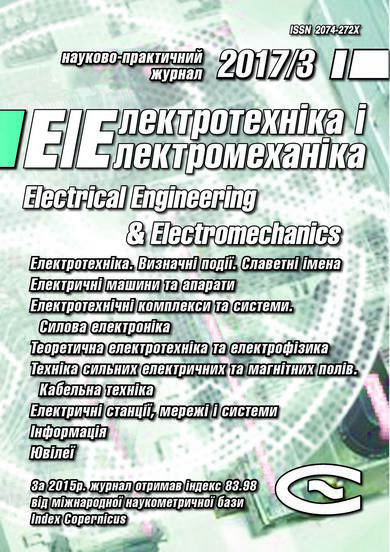NETWORK-CENTRIC TECHNOLOGIES FOR CONTROL OF THREE-PHASE NETWORK OPERATION MODES
DOI:
https://doi.org/10.20998/2074-272X.2017.3.10Keywords:
network-centric control, unmanned aerial vehicle, losses, quality, monitoring, instantaneous powerAbstract
Purpose. The development of the control system for three-phase network is based on intelligent technologies of network-centric control of heterogeneous objects. The introduction of unmanned aerial vehicles for monitoring of three-phase network increases the efficiency of management. Methodology. The case of decomposition of the instantaneous capacities of the fixed and variable components for 3-wire system. The features of power balance for the different modes of its functioning. It should be noted that symmetric sinusoidal mode is balanced and good, but really unbalanced, if the standard reactive power is not zero. To solve the problem of compensation is sufficient knowledge of the total value of the inactive components of full power (value of the inactive power) without detail. The creation of a methodology of measurement and assessment will require knowledge of the magnitudes of each inactive component separately, which leads to the development of a unified approach to the measurement and compensation of inactive components of full power and the development of a generalized theory of power. Results. Procedure for the compensation of the current of zero sequence excludes from circuit the source, as the active component of instantaneous power of zero sequence, and a vector due to a current of zero sequence. This procedure is performed without time delay as it does not require integration. Only a 3–wire system with symmetrical voltage eliminates pulsations and symmetrization of the equivalent conductances of the phases of the task. Under asymmetric voltage, the power is different, its analysis requires the creation of a vector mathematical model of the energy processes of asymmetrical modes of 3–phase systems. Originality. The proposed method extends the basis of the vector method for any zero sequence voltages and shows that the various theories of instantaneous power three wired scheme due to the choice of a basis in a two-dimensional subspace. Practical value. The algorithm and software implementation for the decomposition of the zero sequence current, which allocated the procedure of obtaining null-balanced vectors of phase and interfacial voltage, calculation of active and inactive instantaneous power is zero balanced mode. The simulation results obtained in the software package Matlab by the method of visual programming in Simulink.References
1. Sokol Y.I., Gryb O.G., Shvets S.V. The structural and parametrical organization of elements of a power supply system in the conditions of network centrism. Electrical engineering & electromechanics, 2016, no.2, pp. 61-64. (Rus). doi: 10.20998/2074-272X.2016.2.11.
2. Sokol Y.I., Gryb O.G., Shvets S.V. Network centrism optimization of expeditious service of elements of the power supply system. Electrical engineering & electromechanics, 2016, no.3, pp. 67-72. (Rus). doi: 10.20998/2074-272X.2016.3.11.
3. Shvets S.V., Voropai U. G. Mariechantal aspects of the use of unmanned aerial vehicles. Bulletin of Kharkiv Petro Vasylenko National Technical University of Agriculture, 2016, no.176, pp. 33-34. (Ukr).
4. Denisyuk S.P. Optimization of power consumption for energy saving in systems with converters. Problems of energy saving, 1994, no.2-3, pp. 81-88. (Rus).
5. Prakhovnik A.V. Energy saving: unconventional look and a different strategy. Energetic and electrification, 2008, no.4, pp. 30-33. (Rus).
6. Shidlovsky A.K., Kuznetsov V.G. Povyshenie kachestva elektroenergii v elektricheskikh setiakh [Increase the power quality in electric networks]. Kyiv, Naukova Dumka Publ., 1985. 286 p. (Rus).
7. Zhezhelenko I.V., Saenko Yu.L. Voprosy kachestva elektroenergii v elektroustanovkakh [Issues of power quality in electrical installations]. Mariupol, PSTU Publ., 1996. 173 p. (Rus).
8. Tenti P., Mattavelli P., Tedeschi E. Compensation techniques based on reactive power conservation. 7th Int. Workshop on Power Definitionsand Measurements under Non-Sinusoidal Conditions, Cagliari, Italy, July 2006, pp. 84-90.
9. Sirotin Yu.A. Unbalanced current and the pulsating current at asymmetrical voltage. Tekhnichna elektrodynamika, 2012, no.2, pp. 42-43.
Downloads
Published
How to Cite
Issue
Section
License
Copyright (c) 2017 Ye. I. Sokol, Iu. A. Sirotin, T. S. Ierusalimova, O. G. Gryb, S. V. Shvets, D. A. Gapon

This work is licensed under a Creative Commons Attribution-NonCommercial 4.0 International License.
Authors who publish with this journal agree to the following terms:
1. Authors retain copyright and grant the journal right of first publication with the work simultaneously licensed under a Creative Commons Attribution License that allows others to share the work with an acknowledgement of the work's authorship and initial publication in this journal.
2. Authors are able to enter into separate, additional contractual arrangements for the non-exclusive distribution of the journal's published version of the work (e.g., post it to an institutional repository or publish it in a book), with an acknowledgement of its initial publication in this journal.
3. Authors are permitted and encouraged to post their work online (e.g., in institutional repositories or on their website) prior to and during the submission process, as it can lead to productive exchanges, as well as earlier and greater citation of published work.





